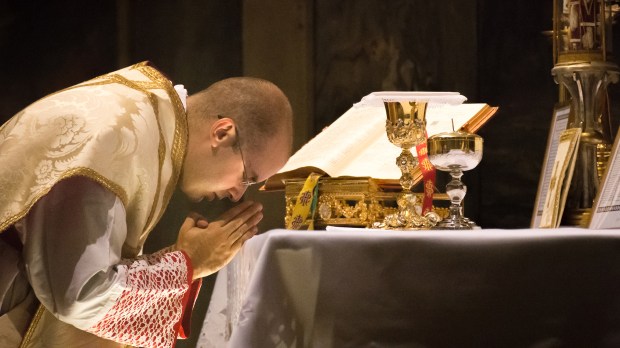The Catholic Church likes to use precise language when describing various beliefs. This attempts to prevent any misunderstandings or inaccurate beliefs about a particular topic.
When it comes to teaching people about the Eucharist, the Church has chosen the word “transubstantiation.”
What does transubstantiation mean?
The Catechism of the Catholic Church uses this word in its section on the Eucharist and offers a succinct summary of its meaning:
The Council of Trent summarizes the Catholic faith by declaring: “Because Christ our Redeemer said that it was truly his body that he was offering under the species of bread, it has always been the conviction of the Church of God, and this holy Council now declares again, that by the consecration of the bread and wine there takes place a change of the whole substance of the bread into the substance of the body of Christ our Lord and of the whole substance of the wine into the substance of his blood. This change the holy Catholic Church has fittingly and properly called transubstantiation.”
CCC 1376
The term has been used since at least the 11th century, and has its roots in Latin.
The Catholic Encyclopedia offers a lengthy philosophical description of this word, comparing it to other forms of transformation:
Transubstantiation, however, is not a conversion simply so called, but a substantial conversion (conversio substantialis), inasmuch as one thing is substantially or essentially converted into another. Thus from the concept of Transubstantiation is excluded every sort of merely accidental conversion, whether it be purely natural (e.g. the metamorphosis of insects) or supernatural (e.g. the Transfiguration of Christ on Mount Tabor). Finally, Transubstantiation differs from every other substantial conversion in this, that only the substance is converted into another — the accidents remaining the same — just as would be the case if wood were miraculously converted into iron, the substance of the iron remaining hidden under the external appearance of the wood.
In the case of the Eucharist, the “substance” (underlying reality) is changed from bread into Jesus’ body and blood while the “accidents” (the outward appearances) remain the same.
Eucharistic miracles are unique in that the “accidents” also change, visibly transforming into Jesus’ flesh.
This teaching can often confuse people, and it can take years to fully comprehend what is happening at Mass.
The key behind it all is to say with the father who asked Jesus to heal his son, “Ibelieve; helpmyunbelief!” (Mark 9:24)
We may not fully understand this mystery, but we can still ask God for help in believing in it.



